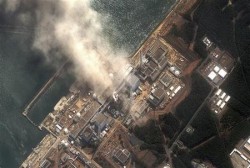Japan braces for potential radiation catastrophe
Japan faced a potential catastrophe Tuesday after a quake-crippled nuclear power plant exploded and sent low levels of radiation floating toward Tokyo, prompting some people to flee the capital and others to stock up on essential supplies.
The crisis appeared to escalate late in the day when the operators of the facility said that one of two blasts had blown a hole in the building housing a reactor, which meant spent nuclear fuel was exposed to the atmosphere.
Prime Minister Naoto Kan urged people within 30 km (18 miles) of the facility - a population of 140,000 - to remain indoors amid the world’s most serious nuclear accident since the Chernobyl disaster in Ukraine in 1986.
Officials in Tokyo - 240 km (150 miles) to the south of the plant - said radiation in the capital was 10 times normal by evening but there was no threat to human health. Around eight hours after the explosions, the U.N. weather agency said winds were dispersing radioactive material over the Pacific Ocean, away from Japan and other Asian countries.
As concern about the crippling economic impact of the nuclear and earthquake disasters mounted, Japan’s Nikkei index fell as much as 14 percent before ending down 10.6 percent, compounding a slide of 6.2 percent the day before. The two-day fall has wiped some $620 billion off the market.
 Authorities have spent days desperately trying to prevent the water which is designed to cool the radioactive cores of the reactors from running dry.
Authorities have spent days desperately trying to prevent the water which is designed to cool the radioactive cores of the reactors from running dry.
The authorities said they may pour water into the fuel pool of the most critical reactor, No. 4, within two or three days, but did not say why they would have to wait to do this.
“The possibility of further radioactive leakage is heightening,” a grim-faced Kan said in an address to the nation earlier in the day.
“We are making every effort to prevent the leak from spreading. I know that people are very worried but I would like to ask you to act calmly.”
Levels of 400 millisieverts per hour had been recorded near the No. 4 reactor, the government said. Exposure to over 100 millisieverts a year is a level which can lead to cancer, according to the World Nuclear Association.
The plant operator pulled out 750 workers, leaving just 50, and a 30-km no-fly zone was imposed around the reactors. There have been no detailed updates on what levels the radiation reached inside the exclusion zone where people live.
“Radioactive material will reach Tokyo but it is not harmful to human bodies because it will be dissipated by the time it gets to Tokyo,” said Koji Yamazaki, professor at Hokkaido University graduate school of environmental science. “If the wind gets stronger, it means the material flies faster but it will be even more dispersed in the air.”
Despite pleas for calm, residents rushed to shops in Tokyo to stock up on supplies. Don Quixote, a multi-storey, 24-hour general store in Roppongi district, sold out of radios, flashlights, candles and sleeping bags.
In a sign of regional fears about the risk of radiation, China said it would evacuate its citizens from areas worst affected but it had detected no abnormal radiation levels at home. Air China said it had canceled some flights to Tokyo.
Several embassies advised staff and citizens to leave affected areas. Tourists cut short vacations and multinational companies either urged staff to leave or said they were considering plans to move outside Tokyo.